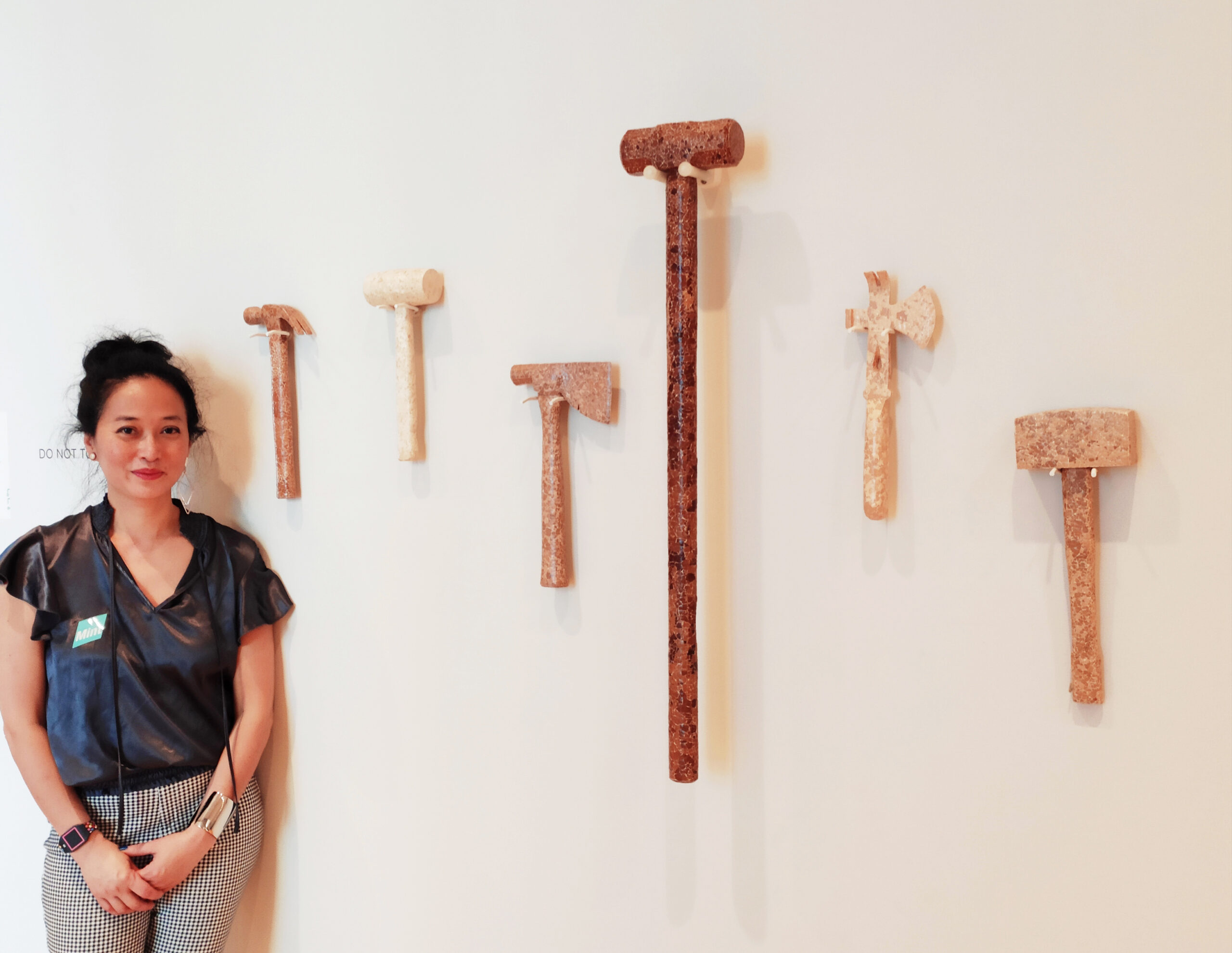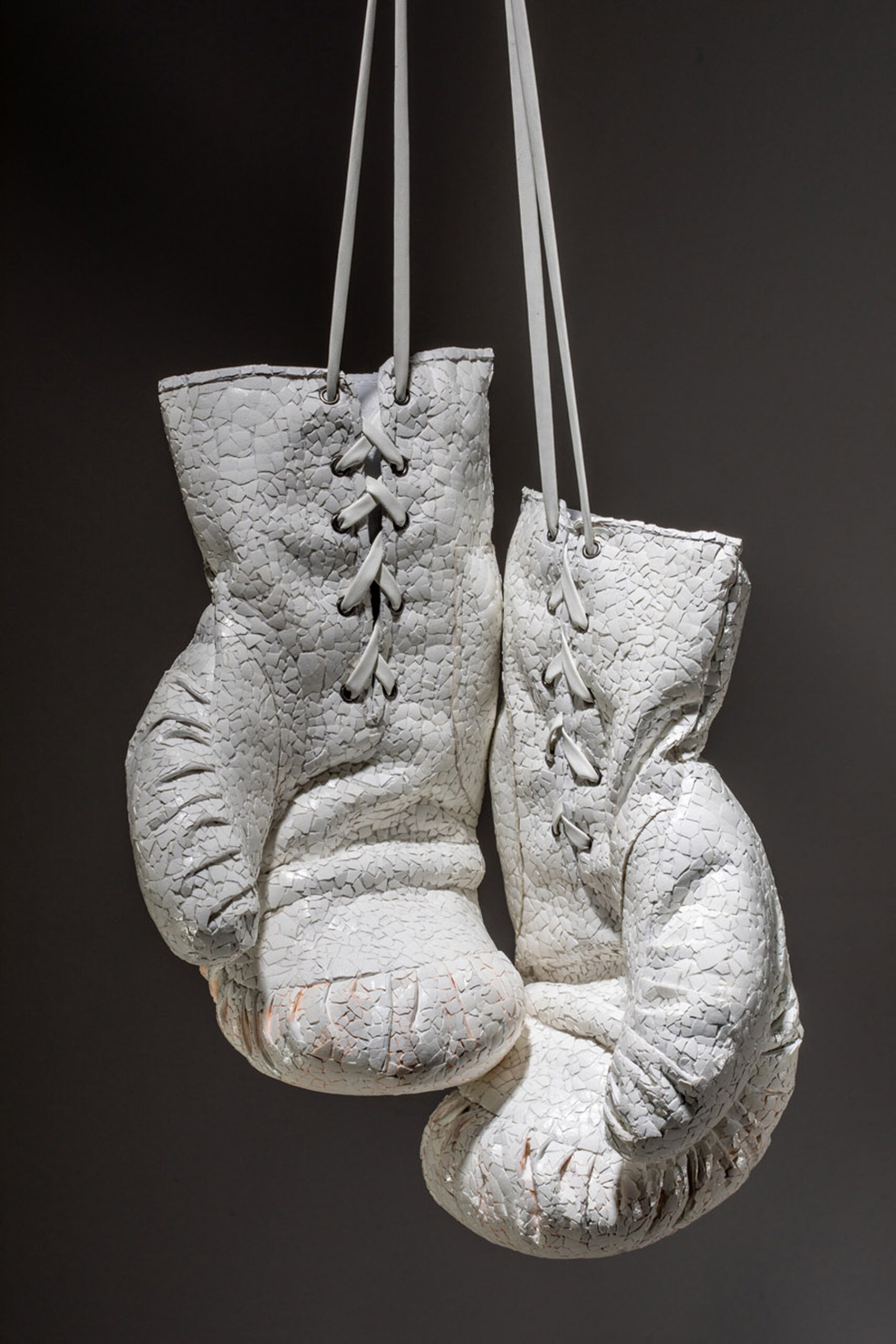
In My Loan Dinh’s series “(Re)constructing the space in-between,” objects, covered in eggshells, appear fragile; but they are strong — strong enough to break glass. “I reach for these tools not only to break barriers, but also to build, forge, and construct new paths towards freedom and equality. Many things, like stones and bullets, can shatter glass. I am here to build,” Dinh says.
‘Broken, but in one piece’
Charlotte artist MyLoan Dinh explores the human condition – and the search for home
By Page Leggett
MyLoan (pronounced “mee-LAHN”) Dinh has been working with an unusually delicate medium: eggshells.
The Vietnamese-American artist, who splits her time between Charlotte and Berlin, uses them to encase objects — passports, hammers, boxing gloves. “With boxing gloves, you think of fighting,” she says. “I love the idea of pairing things that are complete opposites. There’s a tension there — a deeper meaning that starts a conversation.”
People might see the eggshell mosaics and think of the destructiveness of violence or the fragility of life. But for life to begin, the egg has to be open, to be broken, Dinh says. And brokenness is part of being human.
“I like creating something whole out of fragments,” she continues. “I like this idea that even though we might be broken, we’re in one piece. We’re going to be OK.”

MyLoan Dinh, United States (born in Vietnam), 1972– . “Off White,” 2019. Boxing gloves, eggshells, acrylic. Museum purchase made possible by the Charles W. Beam Endowment Fund.
From coop to kitchen to studio
Working with eggshells is tedious and time-consuming. Dinh starts by procuring eggs. She has to boil the eggs, crack and peel them. Then, she methodically places each tiny piece onto the object with an adhesive. She uses a stick pin or a needle; her fingers are too big for the job. Once the entire object is covered, she fills in with even tinier shell shards. She doesn’t want too much of a gap between fragments.
Each object gets covered in five or six protective layers. Something fragile has been made durable.
Some of the “eggshell art” was featured in Dinh’s installation for Constellation CLT — an exhibition series that spotlights local artists — this spring and summer at Mint Museum Uptown.
“I think it’s wonderful that museums are starting to look for artists in their backyard,” Dinh says. “There’s a lot of talent here. And why not expose the community to those artists? It’s wonderful that part of the community can now see themselves in these spaces.”
The part of the community she’s referring to: Asian-Americans. “When I was growing up, I couldn’t see myself in a museum setting because I didn’t have any role models,” she says. “I couldn’t name a single Asian artist. I saw some Asian art, but it was more like artifacts. So, this Constellations program is really amazing.”
‘A place we can call home’
She and her family were on one of the last ships out of Saigon in 1975. Dinh was 4. She has no memory of her homeland but still feels connected to her culture.
Her story is deeply personal, but there’s a universality to it. “Everyone deserves safety,” she says. “We all deserve the same basic human rights, the opportunity to live in dignity and to somehow find a place we can call home.”
Finding her way to safety was harrowing. For six days, they were forbidden to dock because the ships belonged to the now-defunct South Vietnamese government. “We were stateless,” she says.
The U.S.S. Kirk was the first, and then dozens of former South Vietnamese Navy ships, cargo and fishing boats lowered the Vietnamese flag and raised the American one. That was just the beginning.
Dinh’s family went to three different U.S. refugee camps before a Lutheran church in Boone agreed to sponsor them. “We’re still in touch with the pastor and his wife,” Dinh says. “At the time, there was this — not really, anti-Asian hate — but fear. People were afraid for different reasons: Would we be able to adjust? Were we Communists? Half the congregation wasn’t sure should they take us in. The minister told them, ‘As people of God, we have to.’”
They came to Charlotte because there was a bigger Vietnamese population here and it’s a bigger city. Dinh’s parents wanted to find their community.
Dinh herself has found a large creative community here. She and her husband — Till Schmidt-Rempler, a former dancer and choreographer — frequently host musicians, poets, storytellers and dancers in the 1935 log cabin that’s home to the couple and their teenage daughter. (Their son is working toward a PhD in art history in London.)
Evolution of an artist
Dinh’s work has evolved a lot since she first picked up a paintbrush to create what she calls “representational, figurative work.” It didn’t take long for her to expand her subject matter and media; she experiments to stave off boredom. In recent years, she’s been diving into storytelling.
“I began revisiting stories about what my family faced when I was growing up,” she says. “Much of that stuff, you just push away. You focus on your survival. You don’t want to bring it up because you think: ‘I’m resilient, I need to move on.’ But I felt it was time to pull it out slowly because of this shift in America, this racial reckoning.”
She doesn’t consider herself a political artist, but rather an artist concerned with social justice.
She hopes viewers see that concern in her work. “I think it’s good to let viewers enjoy the pieces for what they are, but I also like the idea of them reading my artist’s statement to understand why I made the piece. My message is that we need to find a way to share space with each other.”
‘My daughter ate it’
Dinh doesn’t always use food in her art — although she has coated everyday objects in candy conversation hearts — but she was inspired to create an installation last year using a ubiquitous Asian dessert.
“I created a fortune cookie installation the day after six Asian women were murdered [in Atlanta],” she says. “I just made it, held it in my hand and photographed it for social media. And, when Jen [Sudul Edwards] said she wanted to show it, I had to tell her: It was a real fortune cookie, and my daughter ate it. But I can get more.”
There are six fortune cookies in that little installation, she says, one for each of the six women murdered. The fortunes have numbers on them, and they are real telephone numbers to an actual hotline, Dinh says.
With her eggshell art, Dinh is a purist. She leaves the shells the colors nature intended. But she wanted dark brown eggs for several pieces — and went searching.
“There’s a chocolate brown egg that comes from a fancy French chicken called the Marans chicken, she says. “I joined a Facebook group of people who raise chickens and asked if anybody had Marans chickens. They were so responsive; I’ve been getting eggshells in the mail. Chicken people are really good people.
“You never know where you’ll find your community. And community is really another word for ‘home’.”
Page Leggett’s writing appears regularly in The Charlotte Observer, Business North Carolina and SouthPark magazine. Besides writing, her other great passions are travel and art collecting. The first art lessons she took were at Mint Museum Randolph.
This story previously published in the Winter 2021 Inspired member magazine.